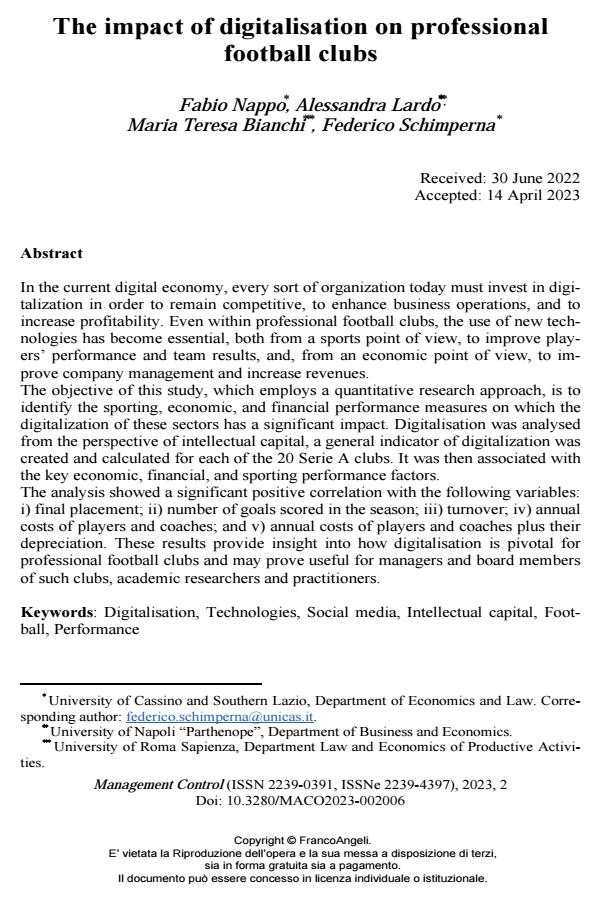The impact of digitalisation on professional football clubs
Titolo Rivista MANAGEMENT CONTROL
Autori/Curatori Fabio Nappo, Alessandra Lardo, Maria Teresa Bianchi, Federico Schimperna
Anno di pubblicazione 2023 Fascicolo 2023/2
Lingua Inglese Numero pagine 20 P. 117-136 Dimensione file 231 KB
DOI 10.3280/MACO2023-002006
Il DOI è il codice a barre della proprietà intellettuale: per saperne di più
clicca qui
Qui sotto puoi vedere in anteprima la prima pagina di questo articolo.
Se questo articolo ti interessa, lo puoi acquistare (e scaricare in formato pdf) seguendo le facili indicazioni per acquistare il download credit. Acquista Download Credits per scaricare questo Articolo in formato PDF

FrancoAngeli è membro della Publishers International Linking Association, Inc (PILA)associazione indipendente e non profit per facilitare (attraverso i servizi tecnologici implementati da CrossRef.org) l’accesso degli studiosi ai contenuti digitali nelle pubblicazioni professionali e scientifiche
In the current digital economy, every sort of organization today must invest in dig-italization in order to remain competitive, to enhance business operations, and to increase profitability. Even within professional football clubs, the use of new tech-nologies has become essential, both from a sports point of view, to improve play-ers’ performance and team results, and, from an economic point of view, to im-prove company management and increase revenues. The objective of this study, which employs a quantitative research approach, is to identify the sporting, economic, and financial performance measures on which the digitalization of these sectors has a significant impact. Digitalisation was analysed from the perspective of intellectual capital, a general indicator of digitalization was created and calculated for each of the 20 Serie A clubs. It was then associated with the key economic, financial, and sporting performance factors. The analysis showed a significant positive correlation with the following variables: i) final placement; ii) number of goals scored in the season; iii) turnover; iv) annual costs of players and coaches; and v) annual costs of players and coaches plus their depreciation. These results provide insight into how digitalisation is pivotal for professional football clubs and may prove useful for managers and board mem-bers of such clubs, academic researchers and practitioners.
Parole chiave:Digitalisation, Technologies, Social media, Intellectual capital, Foot-ball, Performance
- The evolution of the entertainment sector in the metaverse: the case of sports event management Raffaele Trequattrini, Giuseppe Russo, Maria Schimperna, Maria Teresa D'Agostino, in Journal of Intellectual Capital /2026 pp.1
DOI: 10.1108/JIC-10-2024-0313 - Determinants of financial performance of Portuguese football clubs Ricardo Joaquim, Nuno Gonçalves, Liliana Pimentel, Bernardo Simões, in Sport, Business and Management: An International Journal /2025 pp.1
DOI: 10.1108/SBM-01-2025-0021 - DİJİTAL GELİR MODELLERİNİN FUTBOL KULÜPLERİNE EKONOMİK ETKİSİ İsmail Öner, Özgür Karataş, Emine Öztürk Karataş, in Mustafa Kemal Üniversitesi Eğitim Fakültesi Dergisi /2024 pp.137
DOI: 10.56677/mkuefder.1575323
Fabio Nappo, Alessandra Lardo, Maria Teresa Bianchi, Federico Schimperna, The impact of digitalisation on professional football clubs in "MANAGEMENT CONTROL" 2/2023, pp 117-136, DOI: 10.3280/MACO2023-002006